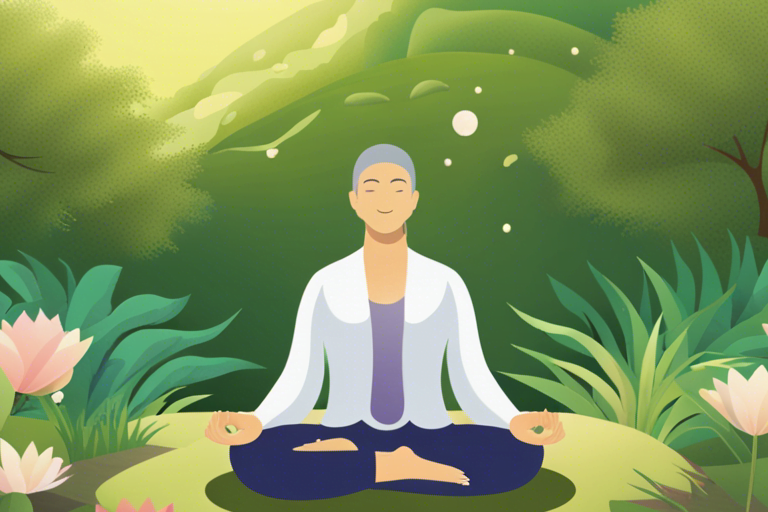In the chaos of the fast-paced digital world, many of us find solace in understanding the mysteries of the human psyche and the depths of spirituality. Welcome to “Spiritual Techniques For The 21st Century” – a blog that bridges the wisdom of psychology with the depth of spirituality. Join me on a journey where we explore the intricate dance between the mind and the spirit, delving into topics such as mindfulness techniques, cognitive behaviors, ancient spiritual traditions, and the science of meditation. Together, we will unravel the secrets to mindful living, embark on inner journeys of self-awareness, investigate the scientific basis behind spiritual experiences, and discover the transformative power of healing and growth. Buckle up and get ready for a captivating exploration that will leave your spirit enlightened and your mind inspired.
Mindful Living
In today’s fast-paced and digitally-driven world, finding inner peace and living a mindful life has become increasingly important. Mindfulness is the practice of bringing full attention and awareness to the present moment, without judgment. It is about being fully present in our thoughts, emotions, and physical sensations, and cultivating a sense of calm and clarity in our daily lives.

Understanding Mindfulness
To truly incorporate mindfulness into our lives, it is important to understand what it is and how it can benefit us. Mindfulness is not a new concept; it has its roots in ancient Eastern traditions such as Buddhism and has been practiced for thousands of years. However, in recent years, it has gained popularity in the Western world as a powerful tool for stress reduction, mental well-being, and personal growth.
Incorporating Mindfulness into Daily Life
Incorporating mindfulness into our daily lives can feel overwhelming at first, but with practice, it becomes a natural and intuitive way of being. There are various ways to incorporate mindfulness into our daily routines, such as practicing mindfulness meditation, engaging in mindful eating, or simply taking a few moments each day to pause and breathe deeply.
Challenges and Benefits of Mindful Living
While living mindfully can bring numerous benefits to our lives, it is not without its challenges. Mindfulness requires a commitment to self-awareness and a willingness to face and accept all aspects of ourselves. It can be challenging to quiet the mind and stay present in a world filled with distractions. However, the benefits of mindful living are well worth the effort – increased self-awareness, reduced stress, improved focus, enhanced relationships, and a greater sense of overall well-being.
Practical Tips for Cultivating Mindfulness
Cultivating mindfulness requires consistent practice and dedication. Here are some practical tips to help incorporate mindfulness into your daily life:
- Start small: Begin with just a few minutes of mindfulness practice each day and gradually increase the duration over time.
- Use reminders: Set reminders on your phone or place sticky notes in visible areas to prompt you to pause and check in with yourself throughout the day.
- Practice gratitude: Take a few moments each day to reflect on the things you are grateful for. This helps shift your focus to the present moment and cultivates a sense of positivity.
- Engage in mindful activities: Find activities that naturally bring you into the present moment, such as gardening, painting, or listening to music. Fully immerse yourself in these activities and notice the sensations, thoughts, and emotions that arise.
- Find a supportive community: Surround yourself with like-minded individuals who are also on a mindful living journey. This can provide encouragement, inspiration, and accountability.
By incorporating mindfulness into our daily lives, we can experience a greater sense of peace, presence, and fulfillment.
Inner Journeys
The journey into our inner selves is a profound and transformative one. It is a journey of self-discovery, self-reflection, and self-awareness. By exploring the depths of our psyche, we can gain a better understanding of our emotions, behaviors, and thought patterns.
Exploring the Human Psyche
The human psyche is a complex and multifaceted entity. It encompasses our thoughts, emotions, memories, beliefs, and desires. Exploring the human psyche involves delving deep into these aspects of ourselves and gaining insight into the underlying factors that shape our thoughts, behaviors, and experiences.
The Power of Self-Awareness
Self-awareness is a foundational aspect of personal growth and transformation. It is the ability to observe and understand our thoughts, emotions, and actions without judgment. By cultivating self-awareness, we can begin to identify patterns, triggers, and limiting beliefs that may be holding us back from living our fullest potential.
Understanding Emotions and Behaviors
Emotions play a significant role in shaping our behaviors and experiences. By understanding and acknowledging our emotions, we can learn to respond to them in a healthy and constructive way. Exploring the relationship between our emotions and behaviors allows us to gain insight into why we react the way we do and make conscious choices to change unhealthy patterns.
Practices for Self-Reflection and Self-Discovery
Self-reflection and self-discovery are crucial components of inner journeys. Through practices such as journaling, meditation, and contemplation, we can deeply explore our thoughts, feelings, and experiences. These practices provide a space for introspection, self-inquiry, and personal growth.
Inner journeys are not always easy or comfortable. They require courage, vulnerability, and a willingness to face our fears and shadows. However, the rewards are immense – greater self-awareness, a deeper understanding of ourselves and others, and a sense of inner peace and alignment.
Spiritual Sciences
The intersection of spirituality and science is a fascinating field of study that explores the mysteries of the universe and the nature of consciousness. It bridges the gap between ancient wisdom and modern scientific inquiry, shedding light on the interconnectedness of all things.
The Science behind Meditation
Meditation has been practiced for thousands of years as a spiritual and healing practice. In recent years, science has begun to unravel the physiological and psychological effects of meditation. Research has shown that meditation can positively impact our brain structure, reduce stress, enhance emotional well-being, and improve cognitive functions.
Exploring Spiritual Experiences
Spiritual experiences are often described as profound, transcendent moments that connect us to something greater than ourselves. These experiences can occur in various forms, such as feelings of awe, deep connection with nature, or moments of spiritual awakening. Exploring these experiences can provide insights into the nature of consciousness and our place in the universe.
The Interconnectedness of All Things
The concept of interconnectedness is central to many spiritual traditions. It suggests that everything in the universe is interconnected and interdependent. This idea is supported by scientific research, such as quantum physics, which reveals that at the fundamental level, all matter and energy are interconnected. Understanding the interconnectedness of all things can foster a sense of unity, compassion, and ecological responsibility.
Bridging Spirituality and Neuroscience
Neuroscience has made significant advancements in understanding the human brain and its functions. By studying the brain, scientists have gained insights into the neurophysiological processes underlying spiritual experiences, meditation, and mindfulness practices. The integration of spirituality and neuroscience offers a holistic understanding of the human experience.
The study of spiritual sciences provides an opportunity to explore the profound mysteries of existence and deepen our understanding of the nature of reality.
Traditions Explored
Throughout history, humanity has developed various spiritual traditions that provide guidance, wisdom, and practices for spiritual growth and self-realization. Exploring these traditions can offer insights into different perspectives on life, meaning, and the journey of the soul.

Ancient Spiritual Traditions
Ancient spiritual traditions, such as Taoism, Sufism, and Shamanism, offer a wealth of wisdom and practices that have stood the test of time. These traditions often emphasize the interconnectedness of all things, the importance of living in harmony with nature, and the cultivation of inner peace and enlightenment.
Teachings and Practices of Buddhism
Buddhism is one of the oldest and most widely followed spiritual traditions in the world. It offers teachings and practices for understanding the nature of suffering, cultivating compassion and wisdom, and transcending the cycle of birth and death. Buddhist practices such as meditation, mindfulness, and the cultivation of loving-kindness have gained widespread recognition for their transformative effects.
The Wisdom of Hinduism
Hinduism is another ancient spiritual tradition that encompasses a wide range of beliefs and practices. It emphasizes the pursuit of self-realization, the understanding of karma and reincarnation, and the recognition of the divine in all beings. Hindu practices such as yoga, mantra chanting, and devotion are widely embraced for their spiritual and transformative benefits.
The Spiritual Path of Christianity
Christianity, one of the world’s major religions, offers a rich spiritual path that centers around the life and teachings of Jesus Christ. It emphasizes love, compassion, forgiveness, and the pursuit of a personal relationship with God. Christian practices such as prayer, worship, and the study of scripture provide guidance and support for spiritual growth.
Exploring various spiritual traditions allows us to broaden our understanding, gain new perspectives, and find common threads that unite humanity in our search for meaning and purpose.
Healing and Growth
Healing and growth are intertwined aspects of the human journey. We all experience challenges, wounds, and traumas that can hinder our well-being and personal growth. By embracing therapeutic principles and tapping into the wisdom of spirituality, we can embark on a journey of healing and transformation.
Therapeutic Principles for Personal Healing
Therapy provides a safe and supportive space for exploring and healing psychological wounds. It encompasses a wide range of techniques and modalities that help individuals gain insight into their thoughts, emotions, and behaviors and develop healthier coping strategies. Therapeutic principles such as empathy, active listening, and unconditional positive regard are essential for fostering healing and growth.
Combining Therapy and Spiritual Wisdom
The integration of therapy and spiritual wisdom can offer a holistic approach to healing and growth. Many therapeutic modalities draw inspiration from spiritual teachings and incorporate mindfulness, meditation, and self-reflection practices. By combining therapeutic principles with spiritual insights, individuals can deepen their healing journey and create lasting positive change.
Insights for Personal Growth
Personal growth is a lifelong process of self-improvement, self-discovery, and self-actualization. It involves developing self-awareness, fostering healthy relationships, and continuously learning and evolving. Through introspection, self-reflection, and the cultivation of positive habits and attitudes, individuals can unlock their full potential and lead fulfilling lives.
Techniques for Self-Transformation
Self-transformation is the process of consciously and intentionally changing oneself for the better. It often involves letting go of old patterns and beliefs that no longer serve us and embracing new ways of being. Techniques such as affirmation, visualization, and energy healing can support self-transformation and facilitate profound personal growth.
Healing and growth are not linear processes; they require patience, perseverance, and compassion for oneself. By embracing both therapeutic principles and spiritual wisdom, individuals can embark on a transformative journey toward healing, self-realization, and personal growth.
Healing Prayer Essence
Prayer has been practiced for centuries as a means of connecting with the divine, seeking guidance, and finding solace in times of struggle. It is a practice that transcends religious boundaries and offers a powerful tool for healing and transformation.
Understanding the Power of Healing Prayer
Healing prayer is a form of prayer that is specifically focused on invoking healing energy for oneself and others. It is based on the belief that prayer has the potential to facilitate physical, emotional, and spiritual healing. By directing our thoughts and intentions towards healing, we open ourselves to the subtle energies and divine guidance that can support the healing process.
How Prayer Can Aid in Healing
Prayer can aid in healing by creating a state of receptivity, opening ourselves to divine intervention, and cultivating a sense of trust and surrender. It allows us to acknowledge our limitations and place our trust in a higher power. Prayer can also provide emotional comfort, reduce stress, and instill a sense of hope and resilience in challenging times.
Ancient and Modern Prayer Practices
Prayer practices vary across different spiritual and religious traditions. From reciting sacred texts and hymns to silent contemplation and visualization, prayer takes many forms. Integrating ancient and modern prayer practices allows individuals to personalize their prayer experience and find a method that resonates with their beliefs and needs.
Harnessing the Healing Energy of Prayer
Prayer is not simply a matter of reciting words or performing rituals; it is a heartfelt connection with the divine. Harnessing the healing energy of prayer involves cultivating a state of deep presence, gratitude, and intention. By aligning our thoughts, emotions, and actions with the energy of healing, we can tap into the transformative power of prayer.
Prayer has the potential to bring comfort, hope, and healing to those who seek it. By exploring the essence of healing prayer and incorporating it into our lives, we can create a sacred space for healing and transformation.
Spiritual Journey Guide
The spiritual journey is a deeply personal and unique path of self-discovery, growth, and connection with something greater than ourselves. Navigating this journey requires guidance, tools, and techniques that can support and inspire us along the way.

Navigating the Spiritual Journey
The spiritual journey is not a linear path with a fixed destination; it is a lifelong process of exploration and self-realization. Navigating this journey involves deep self-inquiry, inner reflection, and a willingness to embrace uncertainty and change. It is a journey of both challenges and rewards, where we continually learn, grow, and evolve.
Tools and Techniques for Spiritual Exploration
There are various tools and techniques that can aid in spiritual exploration and self-discovery. Meditation, journaling, dreamwork, and mindfulness practices are just a few examples. These practices provide a space for introspection, intuitive insights, and the cultivation of a deeper connection with ourselves and the world around us.
Insights from Spiritual Seekers and Teachers
Learning from the experiences and wisdom of spiritual seekers and teachers can provide invaluable insights and inspiration along our own spiritual journey. Through books, workshops, retreats, and online resources, we can access a wealth of knowledge and guidance that can illuminate our path and help us navigate the challenges and doubts that arise.
Creating Your Personal Spiritual Path
While guidance and inspiration from others can be helpful, it is important to remember that the spiritual journey is ultimately a deeply personal and individual path. Each person’s journey is unique, and what works for one individual may not resonate with another. Creating your personal spiritual path involves honoring your own intuition, beliefs, and experiences. It is about finding what brings you joy, peace, and a deep sense of connection with the divine.
The spiritual journey is an ongoing process of exploration and self-discovery. By navigating this journey with an open mind and heart and utilizing the tools, techniques, and guidance available, we can deepen our connection with the divine and uncover our true essence.
Bible Poems Meaning
The Bible is a timeless spiritual text filled with profound wisdom, teachings, and poetry that can inspire spiritual growth and reflection. Exploring the poetry within Bible verses offers an opportunity to dive deeper into the symbolism, meaning, and transformative power of these sacred words.
Exploring the Poetry in Bible Verses
The poetic language used in the Bible adds depth and richness to its teachings. From Psalms to Proverbs, the Bible is filled with verses that use metaphor, imagery, and rhythm to convey profound spiritual truths. Exploring the poetry within Bible verses allows us to experience the beauty and power of these words in a new and transformative way.
Unpacking the Symbolism and Meaning
The poetry in Bible verses often contains rich symbolism and hidden meanings. By unpacking the symbolism and delving into the layers of meaning present in these verses, we can gain deeper insights into the divine truths they convey. Symbols such as light, water, and the wilderness are often used to represent spiritual concepts and experiences.
How Bible Poems Can Inspire Spiritual Growth
Bible poetry has the power to inspire and ignite spiritual growth within us. The use of metaphor and imagery allows us to connect with and understand abstract concepts on a deeper level. By immersing ourselves in the beauty and wisdom of Bible poems, we can open ourselves to divine guidance, deepen our faith, and cultivate a closer relationship with the divine.
Finding Connection with the Divine through Poetry
Poetry has a unique ability to touch our hearts and souls in a way that rational discourse often cannot. By reading and reflecting on Bible poems, we can connect with the divine in a deeply personal and intimate way. The act of reading aloud, meditating on, and memorizing these poems can create a sacred space for communion with the divine and inspire a deeper sense of devotion and reverence.
The poetry within Bible verses offers a rich and transformative spiritual experience. By exploring the symbolism, meaning, and power within these verses, we can embark on a journey of spiritual growth and connection with the divine.
Forgiveness Healing Path
Forgiveness is a powerful and transformative practice that has the potential to heal emotional wounds, free us from resentment, and foster inner peace. Navigating the path to forgiveness requires courage, compassion, and a willingness to let go of the past.
The Transformative Power of Forgiveness
Forgiveness is not about condoning or excusing hurtful actions; rather, it is a conscious choice to release ourselves from the burden of resentment and anger. The act of forgiveness has a profound and transformative power that allows us to heal emotional wounds, reclaim our personal power, and cultivate inner peace and freedom.
Practices and Techniques for Cultivating Forgiveness
Cultivating forgiveness requires ongoing practice and dedication. There are various techniques and practices that can support the forgiveness process, such as journaling, meditation, and forgiveness rituals. These practices provide a space for self-reflection, emotional processing, and the cultivation of empathy and compassion.
Healing Emotional Wounds through Forgiveness
Emotional wounds can be deep and long-lasting, and forgiving those who have hurt us can feel challenging. However, forgiveness is not about forgetting or denying the pain we have experienced; it is about acknowledging our pain, allowing ourselves to grieve, and choosing to let go of resentment and bitterness. It is a journey of self-empowerment and reclaiming our emotional well-being.
Navigating the Path to Forgiveness
The path to forgiveness is not always straightforward or easy. It requires self-compassion, patience, and a willingness to face and process difficult emotions. It may involve seeking support from therapists, support groups, or spiritual leaders who can provide guidance and encouragement along the way. Each person’s path to forgiveness is unique, and it is important to honor our own process and timing.
Forgiveness is a courageous and transformative practice that can free us from the chains of resentment and allow us to experience greater peace, happiness, and emotional well-being. By embarking on the path to forgiveness, we can open ourselves to a profound journey of healing and growth.
Love’s Healing Role
Love is a powerful force that has the potential to heal, transform, and uplift us on both a personal and spiritual level. Cultivating love and compassion within ourselves and in our relationships is an essential part of the healing and growth journey.
The Healing Power of Love
Love has the power to heal wounds, dissolve barriers, and bring about profound transformation. When we approach ourselves and others with love and compassion, we create a safe and nurturing environment for healing and growth to occur. Love can mend broken hearts, soothe emotional pain, and foster a deep sense of connection and belonging.
Practices for Cultivating Love and Compassion
Cultivating love and compassion requires a conscious and intentional practice. There are various techniques and practices that can support the cultivation of love, such as loving-kindness meditation, forgiveness exercises, and acts of service. These practices allow us to expand our capacity for love and deepen our connection with ourselves and those around us.
Love as a Catalyst for Personal and Spiritual Growth
Love is not only a powerful force for personal healing; it can also catalyze our spiritual growth. When we approach life with love and compassion, we open ourselves to the divine flow of grace and wisdom. Love can inspire us to embrace our authentic selves, live in alignment with our values, and make choices that align with our highest good and the well-being of others.
The Role of Love in Healing Relationships
Love plays a fundamental role in healing and transforming our relationships. By approaching our relationships with love and compassion, we can foster empathy, understanding, and forgiveness. Love allows us to see the humanity in others and encourages us to build bridges of connection, even in the face of conflict or differences. It is through love that we can heal and transform our relationships, creating deeper bonds and a greater sense of harmony.
Love is a potent force that has the potential to heal, transform, and bring about profound positive change. By cultivating love and compassion within ourselves and extending it to others, we can create a more peaceful, loving, and fulfilling life for ourselves and those around us.

